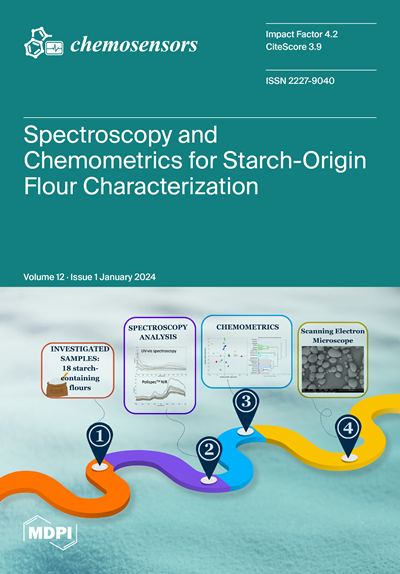气相色谱-质谱联用电子鼻分析及气味活性值计算评价冲绳凤梨选育品系的挥发性特征
IF 3.7
3区 工程技术
Q2 CHEMISTRY, ANALYTICAL
引用次数: 0
摘要
最近对冲绳菠萝的需求增加,有必要开发具有诱人香气的新品种。本研究旨在评价5个冲绳凤梨选育品系的挥发性特性。22”、“没有。25日”、“没有。26日”、“没有。’、‘不’。28日”。采用顶空气相色谱-质谱联用电子鼻法测定冷冻果肉中总挥发物含量。利用主成分分析可视化挥发物的总离子质量,并选择具有可比挥发物特征的每行3个重复。此外,评估这些重复中挥发性成分的组成,并计算气味活性值(oav)。不同的品种在挥发性化合物的数量和组成上各不相同,主要是酯类、酮类、萜烯类和醇类。“没有。22’果实挥发物含量高于其他品系。此外,14种挥发物与OAV >结果表明:2-甲基丁酸甲酯的OAV最高,为786.96;26的线;2,5-二甲基-4-甲氧基-3(2H)-呋喃酮在No。’和‘不’。27岁的行;δ-癸内酯仅存在于' No。’和‘不’。这表明这些新育种品系具有不同的有效实际用途。本文章由计算机程序翻译,如有差异,请以英文原文为准。
Assessment of Volatile Characteristics of Okinawan Pineapple Breeding Lines by Gas-Chromatography–Mass-Spectrometry-Based Electronic Nose Profiling and Odor Activity Value Calculation
The recent increase in demand for Okinawan pineapples has necessitated the development of new varieties with attractive aromas. This study aimed to evaluate the volatile characteristics of five Okinawan pineapple breeding lines, i.e., ‘No. 22’, ‘No. 25’, ‘No. 26’, ‘No. 27’, and ‘No. 28’. The total volatiles in the cryopulverized fruit flesh were examined using headspace gas-chromatography–mass-spectrometry-based electronic nose analysis. The total ion masses of the volatiles were visualized using principal component analysis, and three replicates of each line with comparable volatile characteristics were selected. Furthermore, the composition of the volatile components in these replicates was assessed, and the odor activity values (OAVs) were calculated. The breeding lines varied in the quantity and composition of their volatile compounds, which were predominantly esters, ketones, terpenes, and alcohols. The ‘No. 22’ fruit contained a greater content of volatiles than the other lines. Moreover, 14 volatiles with OAV > 1 were accounted as aroma-active compounds, and their variations were distinguished as follows: the highest OAV (786.96) was recorded for methyl 2-methylbutanoate of the ‘No. 26’ line; 2,5-dimethyl-4-methoxy-3(2H)-furanone was superior in the ‘No. 26’ and ‘No. 27’ lines; and δ-decalactone was only present in the ‘No. 22’ and ‘No. 27’ fruits, suggesting different potent practical uses for these new breeding lines.
求助全文
通过发布文献求助,成功后即可免费获取论文全文。
去求助
来源期刊

Chemosensors
Chemistry-Analytical Chemistry
CiteScore
5.00
自引率
9.50%
发文量
450
审稿时长
11 weeks
期刊介绍:
Chemosensors (ISSN 2227-9040; CODEN: CHEMO9) is an international, scientific, open access journal on the science and technology of chemical sensors published quarterly online by MDPI.The journal is indexed in Scopus, SCIE (Web of Science), CAPlus / SciFinder, Inspec, Engineering Village and other databases.
 求助内容:
求助内容: 应助结果提醒方式:
应助结果提醒方式:


